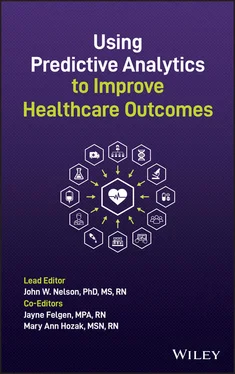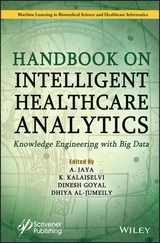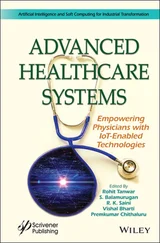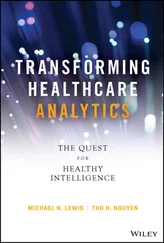Using Predictive Analytics to Improve Healthcare Outcomes
Здесь есть возможность читать онлайн «Using Predictive Analytics to Improve Healthcare Outcomes» — ознакомительный отрывок электронной книги совершенно бесплатно, а после прочтения отрывка купить полную версию. В некоторых случаях можно слушать аудио, скачать через торрент в формате fb2 и присутствует краткое содержание. Жанр: unrecognised, на английском языке. Описание произведения, (предисловие) а так же отзывы посетителей доступны на портале библиотеки ЛибКат.
- Название:Using Predictive Analytics to Improve Healthcare Outcomes
- Автор:
- Жанр:
- Год:неизвестен
- ISBN:нет данных
- Рейтинг книги:5 / 5. Голосов: 1
-
Избранное:Добавить в избранное
- Отзывы:
-
Ваша оценка:
- 100
- 1
- 2
- 3
- 4
- 5
Using Predictive Analytics to Improve Healthcare Outcomes: краткое содержание, описание и аннотация
Предлагаем к чтению аннотацию, описание, краткое содержание или предисловие (зависит от того, что написал сам автор книги «Using Predictive Analytics to Improve Healthcare Outcomes»). Если вы не нашли необходимую информацию о книге — напишите в комментариях, мы постараемся отыскать её.
Discover a comprehensive overview, from established leaders in the field, of how to use predictive analytics and other analytic methods for healthcare quality improvement. Using Predictive Analytics to Improve Healthcare Outcomes
before
proven in advance
Using Predictive Analytics to Improve Healthcare Outcomes
Using Predictive Analytics to Improve Healthcare Outcomes — читать онлайн ознакомительный отрывок
Ниже представлен текст книги, разбитый по страницам. Система сохранения места последней прочитанной страницы, позволяет с удобством читать онлайн бесплатно книгу «Using Predictive Analytics to Improve Healthcare Outcomes», без необходимости каждый раз заново искать на чём Вы остановились. Поставьте закладку, и сможете в любой момент перейти на страницу, на которой закончили чтение.
Интервал:
Закладка:
If predictive analytics can help a team win more games, why couldn’t they help patients heal faster? Why couldn’t they help clinicians take better care of themselves? Why couldn’t predictive analytics be used to improve every outcome in healthcare?
As a data scientist and operations analyst, it is my job to present data to healthcare leaders and staff members in a way that allows them to easily understand the data. Therefore, it is the job of this book to help people in healthcare understand how to use data in the most meaningful, relevant ways possible, in order to identify the smartest possible operational improvements.
For decades, the three editors of this book have been conducting research to measure some of the most elusive aspects of caring. This book provides instructions and examples of how to develop models that are specified to the outcomes that matter most to you, thereby setting you up to use predictive analytics to definitively identify the most promising operational changes your unit or department can make, before you set out to change practice.
List of Acronyms
A&OAlert and orientedACCFAmerican College of Cardiology FoundationACEAngiotensin‐converting enzymeACEIAngiotensin‐converting enzyme inhibitorAGFIAdjusted goodness of fit indexAHAAmerican Heart AssociationAMIAcute myocardial infarctionANEFAcademy of Nursing Education FellowANOVAAnalysis of varianceAPNAdvanced practice nurseARBAngiotensin receptor blockersARNIAngiotensin receptor‐neprilysin inhibitorASAMAmerican Society of Addiction MedicineAuto‐Falls RASAutomated Falls Risk Assessment SystemBNPBrain natriuretic peptideBSNBachelor of science in nursing (degree)BUNBlood urea nitrogenCACCoronary artery calciumCADCoronary artery diseaseCARICOMCaribbean Community (a policy‐making body)CATCaring Assessment ToolCBASCaring Behaviors Assurance System©CDIChoice Dynamic InternationalCFIComparative fit indexCCUCoronary care unitCDCCenters for Disease ControlCEOChief executive officerCESCaring Efficacy ScaleCFSCaring Factor Survey©CFS‐CMCaring Factor Survey – Caring of ManagerCFS‐CSCaring Factor Survey – Caring for SelfCFS‐CPVCaring Factor Survey – Care Provider VersionCFS‐HCAHPSCaring Factor Survey – hospital consumer assessment of healthcare providers and systems (a 15‐item patient/provider survey)CKDChronic kidney diseaseCLCentral lineCLABSICentral line‐associated bloodstream infectionCMSCenters for Medicare and Medicaid ServicesCNACertified nursing assistantCNOChief nursing officerCNSClinical nurse specialistCOPDChronic obstructive pulmonary diseaseCPMClinical Practice ModelCPRCardiopulmonary resuscitationCPSCaring Professional ScaleCRTCardiac resynchronization therapyCRT‐DCardiac resynchronization therapy defibrillatorCRT‐PCardiac resynchronization therapy pacemakerCVACerebrovascular accidentCQIContinuous quality improvementCVCCentral venous catheterCHCMCreative Health Care Management®DNPDoctor of nursing practiceDNRDo not resuscitateDNR‐BAllows aggressive care, but not to the point of cardiopulmonary resuscitationDVTDeep vein thrombosisEDEmergency departmentEFEjection fractionEFAExploratory factor analysisEKGElectrocardiogramEKG QRSA segment of the EKG tracingELNECEnd‐of‐Life Nursing Education ConsortiumEMRElectronic medical recordESCEuropean Society of CardiologyFAANFellow American Academy of NursingFTEFull‐time employeeGFRGlomerular filtration rateGLMGeneral linear modelGPUGeneral patient‐care unitGWTGGet With The Guidelines (measurement tool)HAIHospital‐acquired infectionHCAHealing Compassion AssessmentHCAHPSHospital Consumer Assessment of Healthcare Providers and SystemsHEEHealth Education of EnglandHESHealthcare Environment Survey (measurement instrument)HFHeart failureHMOHealth maintenance organizationICDImplantable cardioverter defibrillatorICUIntensive care unitIRBInstitutional review boardIVIntravenous or information valueI2E2 Inspiration, infrastructure, education and evidenceIOMInstitute of MedicineKMOKaiser–Myer–Olkin (mathematical tool)LOSLength of stayLCSWLicensed clinical social workerLVNLicensed vocational nurseLVSDLeft ventricle systolic dysfunctionMATMedication‐assisted treatmentMBEMember of the British EmpireMICUMedical intensive care unitMFSMorse Falls ScaleMLMachine learningMSNMaster of science in nursing (degree)MRNMedical record numberNANursing assistantNHSNational Health ServiceNHSNNational Healthcare Safety NetworkNICENational Institute of Health and Care ExcellenceNNMCNichols–Nelson Model of ComfortNT‐proBNPN‐terminal pro‐brain natriuretic peptideO2 OxygenOTOccupational therapist/occupational therapyOUDOpioid use disorderPCPalliative carePCAPatient care attendantPCIPercutaneous coronary interventionPICCPeripherally inserted central catheterPMTPacemaker mediated tachycardiaPNPneumoniaPCLOSEAn indicator of model fit to show the model is close‐fitting and has some specification error, but not very much.POLSTPhysician orders for life sustaining treatmentsPPCIProfessional Patient Care IndexPRPregnancy relatedPSIPerformance and safety improvementPSI RNPerformance and safety improvement registered nurseQIQuality improvementQRS(See EKG QRS)RA programming language for statistical computing supported by the R Foundation for Statistical Computing.R4NName of medical unitR6SName of medical unitRAA or R+A+AResponsibility, authority, and accountabilityRBBBRight bundle branch blockRBCRelationship‐Based Care®RMCRecovery management checkupsRMSEARoot mean square error of approximationRNRegistered nurseSAMSASubstance Abuse and Mental Health Services AdministrationSASStatistical Analysis System is a software system for data analysisSBPSystolic blood pressureScDDoctor of scienceSCIPSurgical care improvement projectSCNSenior charge nurseSCUStep‐down unitSEMStructural equation modelSPSSStatistical Package for the Social Sciences is a software system owned by IBM (International Business Machines)SRMRStandardized root mean square residualSTSSociotechnical systems (theory)ST‐TSegment of the heart tracing in an electrocardiographSUDSubstance use disorderTIATransient ischemic attackTIPTreatment improvement protocolsTLCTriple lumen catheterTTETransthoracic echocrdiogramUTDUnable to determineVSVital signVS: SBPVital sign: systolic blood pressureVS: DBPVital sign: diastolic blood pressure
Acknowledgments
First, the three editors of this book would like to acknowledge our developmental editor, Rebecca Smith, who has made the inaccessible, complex concepts of data analytics simple to understand and exciting to contemplate.
Secondly, we would like to acknowledge all the analysts and mathematicians from other disciplines who have enthusiastically and humbly shared their knowledge of mathematics and how it is applied in science. We have been inspired by the depth and breadth of what you know and by your eagerness to learn from others. The lead editor would also like to ask the indulgence of all of the mathematicians, analysts, and scientists who will read this book, as you encounter moments in this book where brevity and simplicity have taken precedence over thorough scientific explanations. In an effort to make this book accessible to a lay audience, much of the technical talk has been truncated or eliminated.
Thirdly, we acknowledge the visionary leaders who had the courage to step out and measure what matters—behavior and context. Without your understanding that data beyond frequencies was needed, the ability to use predictive analytics to improve healthcare outcomes would still be an elusive dream.
Finally, the editors of this book acknowledge all the staff members who took part in these studies. Every one of you made each model of measurement better, and you played a vital part in producing the groundbreaking findings in this book. Without you, this book would not exist.
1 Using Predictive Analytics to Move from Reactive to Proactive Management of Outcomes
Интервал:
Закладка:
Похожие книги на «Using Predictive Analytics to Improve Healthcare Outcomes»
Представляем Вашему вниманию похожие книги на «Using Predictive Analytics to Improve Healthcare Outcomes» списком для выбора. Мы отобрали схожую по названию и смыслу литературу в надежде предоставить читателям больше вариантов отыскать новые, интересные, ещё непрочитанные произведения.
Обсуждение, отзывы о книге «Using Predictive Analytics to Improve Healthcare Outcomes» и просто собственные мнения читателей. Оставьте ваши комментарии, напишите, что Вы думаете о произведении, его смысле или главных героях. Укажите что конкретно понравилось, а что нет, и почему Вы так считаете.












